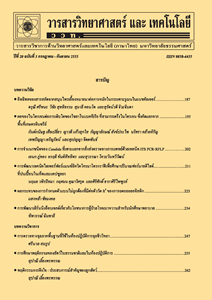พฤกษเคมีและฤทธิ์ทางชีวภาพของชาเล็บรอก
Main Article Content
Abstract
บทคัดย่อ
Toddalia asiatica (L.) Lam หรือเล็บรอก เป็นสมุนไพรในท้องถิ่นพบในประเทศไทยพบพืชนี้ที่ภูมิภาคตะวันออกเฉียงเหนือ และภาคใต้ รวมถึงในจังหวัดเพชรบุรีและประจวบคีรีขันธ์ แต่ยังไม่เป็นที่นิยมรับประทานมากเท่าในจังหวัดชุมพรและภาคใต้ของประเทศ เล็บรอกมีสรรพคุณช่วยลดไขมันในเส้นเลือด เพราะมีรสชาติที่เผ็ดร้อนและปัจจุบันเล็บรอกถูกนำมาวิจัยในหลายด้านเพื่อหาฤทธิ์ทางชีวภาพ ดังนั้นในการวิจัยครั้งนี้มีวัตถุประสงค์เพื่อศึกษาฤทธิ์ต้านออกซิเดชันส่วนต่าง ๆ ของเล็บรอก ด้วยวิธี DPPH และ nitric oxide ศึกษาพฤกษเคมีเบื้องต้นในส่วนที่ดีที่สุดในการต้านออกซิเดชัน และศึกษาฤทธิ์ต้านออกซิเดชันของชาเล็บรอก โดยมีวิตามินซีเป็นสารมาตรฐาน ด้วยวิธี DPPH และ nitric oxide วัดค่าการดูดกลืนแสงอัลตราไวโอเลตที่ความยาวคลื่น 515 และ 546 นาโนเมตรตามลำดับ การวิจัยครั้งนี้เก็บเล็บรอกทุกส่วนที่จังหวัดชุมพร ในเดือนสิงหาคม พ.ศ. 2557 ในการเตรียมชาเล็บรอกนำผงกิ่งเล็บรอก 2.00 กรัมบรรจุในถุงชา แล้วชงที่อุณหภูมิ 60-100 oC ระยะเวลาชง 1-10 นาที สถิติที่ใช้ ได้แก่ ค่าเฉลี่ย ค่าเบี่ยงเบนมาตรฐาน ผลการวิจัยพบว่าส่วนของกิ่งแสดงฤทธิ์ต้านออกซิเดชันเบื้องต้นสูงสุดที่ความเข้มข้นสุดท้าย 125 µg/ml มีร้อยละการยับยั้งการเกิดออกซิเดชันเป็น 64.86 ส่วนใบและรากมีร้อยละการยับยั้งการเกิดออกซิเดชันเป็น 29.72 และ 41.21 ตามลำดับ กิ่งแสดงฤทธิ์ต้านออกซิเดชันด้วยค่า IC50±S.D. เท่ากับ 89.65±1.00 µg/ml โดยวิตามินซีมีค่า IC50±S.D. เท่ากับ 59.38±0.00 µg/ml ส่วนการทดสอบฤทธิ์ต้านออกซิเดชันด้วยวิธี nitric oxide สารสกัดทุกส่วนไม่แสดงฤทธิ์การต้านออกซิเดชัน การศึกษาสารสำคัญเบื้องต้นในกิ่งเล็บรอก พบสารในกลุ่มแอลคาลอยด์ แทนนิน คูมาริน และสเตอรอยด์ในพืชเป็นองค์ประกอบ การศึกษาการต้านออกซิเดชันเบื้องต้นชาเล็บรอกพบว่าที่ 70 oC เวลา 10 นาที ชาเล็บรอกสามารถต้านการออกซิเดชันด้วยวิธี DPPH ร้อยละ 27.04±2.88 ที่ความเข้มข้นสุดท้าย 2.5 % (v/v) ทั้งสารสกัดและชาจากกิ่งเล็บรอกไม่แสดงความเป็นพิษต่อเซลล์ไตลิงที่ความเข้มข้นสุดท้าย 50 µg/ml และ 2.5 % (v/v) ตามลำดับ
คำสำคัญ : เล็บรอก; ฤทธิ์ทางชีวภาพ; พฤกษเคมี
Abstract
Toddalia asiatica (L.) Lam. known as Lebrog in Thai was a local herbal plant found in Thailand, especially in the North-Eastern and Southern parts including Phetchaburi and Prachuap Khiri Khan Provinces. However, this herbal plant is consumed extensively by only people in Chumphon and other provinces in the Southern area. It has clolesterol-lowering property in blood vessels due to its hot and spicy taste. Currently, the herbal plant was has been tested for its biological activities. This research was conducted to: (1) examine the antioxidant activities of different parts of T. asiatica with DPPH and nitric oxide methods, (2) determine phytochemical constituents in the part of T. asiatica possessing the best antioxidant activities, and (3) examine its antioxidant properties in its tea form compared with vitamin C substance standard. By employing DPPH and nitric oxide methods, measure of ultra-violet absorbance was measured at 515 and 546 nm, respectively. All tested parts of T. asiatica were collected in Chumphon Province in August 2014. To prepare Lebrog in tea from, 2.0 g of its twig powder was packed in a tea bag and then brewed in warm to hot water in the temperature ranging from 60-100 oC for about 1-10 minutes. The data were analyzed for percentage, mean, and standard deviation. At the maximum concentration of 125 µg/ml, the results showed that the twig extract of the plant exerted strong DPPH scavenging activity of 64.86 % followed by its leaf and root extracts with 29.72 and 41.21 %, respectively. The twig extract and vitamin C had the IC50 values of 89.65+1.00 µg/ml and 59.38+0.00 µg/ml, respectively. Studies on the antioxidant activity against nitric oxide showed that all the plant extracts did not have such activity. In addition, the study found that this herbal plant contained alkaloids, tannins, coumarin, and phytosterol as potential components. Also, the study found that the tea form of this plant when brew in hot water in 70 oC for 10 minutes with DPPH method, had DPPH scavenging activity of 27.04+2.88 % at the maximum concentration of 2.5 % (v/v). Both the extract and tea from its twig powder did not show cytotoxicity against Vero cells at the final concentrations of 10 µg/ml and 2.5 % (v/v), respectively.
Keywords: Toddalia asiatica; biological activity; phytochemical


